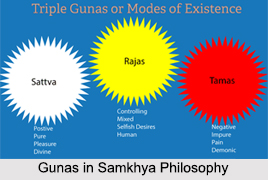 According to Samkhya Philosophy the whole universe is based on three gunas in different proportions. It is an analogy of three strands of a rope or chord that are a constituent strand of primordial materiality. The three gunas in Samkhya Philosophy are sattva (virtue, goodness), rajas (passion, activity), and tamas (darkness, dullness).
According to Samkhya Philosophy the whole universe is based on three gunas in different proportions. It is an analogy of three strands of a rope or chord that are a constituent strand of primordial materiality. The three gunas in Samkhya Philosophy are sattva (virtue, goodness), rajas (passion, activity), and tamas (darkness, dullness).
In Samkhya Philosophy, the term guna also comes to encompass the entire range of subjective and objective reality, whether manifest (Vyakta) or unmanifest (Avyakta). It becomes the thread that runs through all of ordinary experience and throughout the natural world, tying together, as it were, the tattva realm, bhava realm and bhuta realm.
Nature of Gunas in Samkhya Philosophy
In Samkhya Philosophy, it is said that Prakriti is the root cause of the universe and its complexity is the result of it being constituted of three gunas. The term guna is a constituent element or component and not an attribute or quality. It is said, that there are various levels to the gunas in Samkhya Philosophy, on one level, guna is secondary which means it is secondary to what is primary or principal- Pradhana. And on another level, guna implies the moral distinctions related to the activity of the Prakriti as the basis of moral excellence, decadence and indifference. The three distinct gunas in Samkhya Philosophy are elaborately discussed below:
Sattva: The first guna, Sattva means potential consciousness and is used to signify the power of nature that illuminates and reveals all. Under Sattva guna there exist Prakasha or illumination, Sukha or happiness and Preeti or attraction. Sattva is responsible for the manifestation of objects in the physical dimension and in itself is knowledge or wisdom. The nature of Sattva is to provide happiness at the mental level and thus one can say that contentment, satisfaction, euphoria, happiness and bliss are the different effects of this guna.
Rajas: The second guna or Rajas has its root in the word called ranj, which means colour to be attached to or moved. Rajas guna signifies that power of nature which affects and moves the other two constituents. Under this guna, there exist Kriya or motion, Dukha or pain and Apreeti or rejection. Responsible for all motion and change that goes on throughout nature, this guna in Samkhya Philosophy functions to move things and overcome resistance.
Tamas: The third guna or Tamas means darkness, under this exist qualities like Nishkriyata or passivity, Udasinata or indifference and Vishada or despair. Tamas is used to signify that power of nature which restrains, obstructs and envelops the other two constituents by counter-acting the deeds of Rajas and Sattva to reveal. Restraining and binding are its nature. It produces the state of indifference and ignorance. Tamas hinders the power of manifestation in the mind, the intellect and thereby produces ignorance and darkness and bewilderment which are also known as moha.
Brief Overview of Gunas in Samkhya Philosophy
Thus it can be inferred that the three gunas in Samkhya Philosophy produces pleasure, pain and sloth respectively. The gunas are nothing but a particular manifestation or appearance of a subtle entity that merely signifies the manner in which a substance reacts. The gunas in Samkhya Philosophy are beyond the senses and they are inferred from their effects. They are mutually opposed to one another but can operate together to achieve a common purpose. To summarise, the gunas are the root of all change, the foundation of reality, the essence of all things and before the manifestation of the objective world, they are in a state of perfect balance.



















